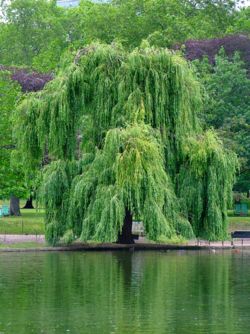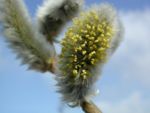Willow
| Willow |
|---|

|
| Scientific Classification |
|
| Subtaxa |
|
About 350, including:
S. acutifolia - Violet Willow |
Willow trees are generally depicted as majestic and wise old trees, filling the entire horizon. That is not always the case however. There are some species of the willow, such as the, Dwarf willow (Salix herbacea), which almost never grows taller than 6cm. The Dwarf Willow, although short in stature, spreads like wild flowers across the fields making up for it's height in square footage. There are around 350 different species of willows, each unique in their own way and each specifically designed the way they are. The most commonly heard of willow, is the Weeping willow.[1]
Anatomy
Willow trees vary in size from 6cm (Dwarf Willow) to 20-30' (Pussy Willow). Their branches are long a thin giving them a natural droop which people have compared to an umbrella. The leaf of a willow has the shape of a long oval that comes to a point, sometimes with serrated edges but normally flat. The branches of the willow are generally fuzzy as young sprouts. The flowering buds of the willow are furry and have only one bud scale. The leaves color is green in the blooming season and turn brownish red in the fall when they lose their branches.[2][3]
Reproduction
The willow tree reproduces asexually, although it can perform sexual reproduction. The most common way for the willow tree to start a new tree is to grow its branches straight into the ground. When the branches reach the ground the take root and eventually become their own tree. The disadvantage of the tree reproducing in this fashion is that it is making a genetic clone of itself. Whereas in sexual reproduction the gene pool varies creating an entirely new tree without identical DNA. Sexual reproduction is not needed if the plant has already found its niche and does not expect to be moved.(Purves 761-763)
Ecology
Willow plants live in wet areas. Willow trees are highly dependent on large water sources. If their supply of water runs out, they will branch their roots out and search for water. Willow trees are not good to have in urban areas because their roots will wrap around the water lines and snap them open to produce a water source for growth. For this reason, when grown in populated areas they are kept well away from underground pipelines, waterlines and septic lines. [4][5]
Medicinal Uses
The willow tree can be used for decorative purposes, however it is also used for medicinal purposes. Willow bark can be used, like other plants, to relive headaches and fevers. The ingredient used is salicylic acid, which is a common ingredient in aspirin as well. (Purves 767)
Symbolism
The willow tree is very symbolic. Some see the tree as a protector, spreading its "arms" around those to protect them. Others see the willow as showing grief. The weeping willow has, by some, been called the Biblical tree because they were thought to be the willows of Babylon. Because of this they were given the name Salix babylonica. Many grave sites have weeping willows personifying the depression of the location. Also many grave stones have willow trees on them, or drooping angles which developed from the idea of the weeping willow. [6]
Gallery
Weeping willow (S. babylonica)
White willow (S. alba)
Related References
- Weeping Willow
- wikipedia
- Yale
- Purves, William K. et al. Life: The Science of Biology. Gordensville, VA. 2004.







